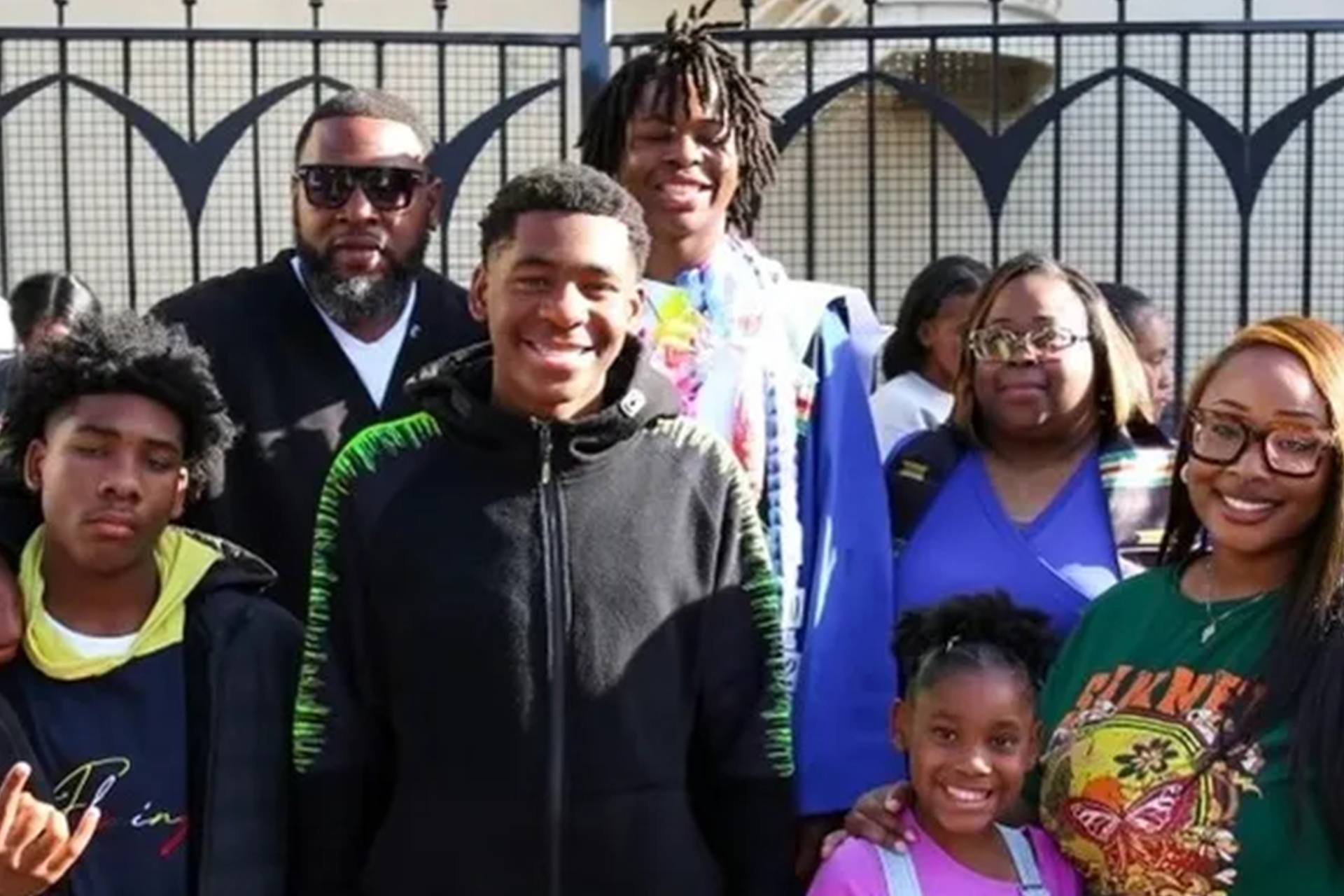Once the backbone of the Democratic base, working-class white voters have been migrating toward the Republican Party since the 1960s, largely out of alienation from the Democrats’ liberal stands on cultural and racial issues. Half a century later, those working-class white voters—usually defined as having less than a four-year college education—have become the indisputable foundation of the Republican coalition, especially in the era of Donald Trump.
Now a chorus of centrist and right-leaning political analysts are claiming that the same shift has begun among working-class nonwhite voters, especially Latinos.
“We’re seeing a political realignment in real time,” Axios insisted in a recent analysis. “Democrats are becoming the party of upscale voters concerned more about issues like gun control and abortion rights. Republicans are quietly building a multiracial coalition of working-class voters, with inflation as an accelerant.”
If correct, these claims would offset, or even eliminate, the advantage Democrats expect from the demographic change that has steadily increased the share of the vote cast by people of color by about two percentage points every four years. Growth among working-class Latino voters, in particular, would offer the Republicans an escape from the demographic cul-de-sac in which their core constituencies of non-college-educated and white Christian voters have each fallen to only about two-fifths of the total population.
There’s no disagreement that Trump, despite all the controversies surrounding his hard-line immigration policies and his often harsh rhetoric about immigrants, ran better among Latinos in 2020 than he did in 2016. And there’s no dispute that President Joe Biden’s approval rating among Latinos has sagged, just as it has in most polls among other groups.
But whether these results amount to a lasting realignment among working-class Latino voters is much more disputed—as is the assertion that rejection of liberal cultural values is the principal cause of the recent Democratic difficulties with them. “I would say there’s a difference between a dominant narrative and dominant data,” Fernand Amandi, a Democratic pollster who specializes in Latino voters, told me.
The best evidence in polling and election results suggests that claims of a fundamental shift among non-college-educated Latino voters (who comprise about 85 percent of all U.S. Latinos) is, at best, wildly premature. But that doesn’t mean that the ground isn’t shaking in the Latino community.
“The only honest answer is that nobody actually knows, and it’s maddening the extent to which we are not acknowledging the uncertainty here,” Carlos Odio, the senior vice president of Equis Research, a Democratic firm that focuses on Latino voters, told me. He believes that those who claim Democrats face “an irreversible death spiral” with Latinos are “exaggerating this moment.” But even so, “the degree of uncertainty and variability right now should be nerve-racking for Democrats,” he said.
The major data sources about the election results differ on exactly how much stronger Trump performed last election, but broadly they suggest that Biden won Latino voters in 2020 by roughly 30 percentage points, after Hillary Clinton had carried them in 2016 by about 40 percentage points.
The shift was most visible in South Florida (with its large population of Cuban Americans and immigrants from Central and South America) and South Texas (with a large culturally conservative population of rural and small-town Mexican Americans). But gains for Trump were evident in every key state. Demographically, he found support across a wide range of groups as well, but the most important change may have been that, in 2020, a considerably higher share of Latinos who identify as conservative voted Republican than in 2016 or 2012, according to the exit polls conducted by Edison Research for a consortium of media organizations. Taken together, all of these factors pushed Trump’s Latino support to about 35 percent—well above his 2016 showing but in range of what Republicans have carried in many other presidential races since 1980.
Biden’s standing among Latinos has fallen sharply; multiple recent polls place his approval rating among them at less than 50 percent and sometimes at as little as 40 percent. Biden’s fall has exerted a downward pull on Latino support for other Democrats, with multiple surveys showing the party holding a much narrower advantage among them than usual in the so-called generic ballot for the House of Representatives.
These two dynamics are propelling claims that Latinos are undergoing a structural realignment, in which more of them are recoiling from “woke” cultural liberalism and concluding that the GOP better reflects their values.
“While there certainly was a white vs. black dimension to the working class realignment of the 1960s, today it’s mostly just white progressives against everyone else,” Patrick Ruffini, a Republican pollster, insisted in a recent tweet. “Hispanic voters will find a religious connection with many, many white Republicans, and that religious connection can prove far more culturally and politically consequential than any effort to create a politics based on ethnic or racial identity,” David French, a conservative writer critical of Trump (and an Atlantic contributor), recently declared. Almost daily, a different New York Times writer offers some version of the claim that, as David Leonhardt wrote last week, “the social liberalism of Democrats—on immigration, marijuana, L.G.B.T. rights, affirmative action, abortion and more—has simultaneously attracted progressive college graduates and repelled more culturally conservative working-class voters.”
In making these claims, the realignment camp is using something of a double standard. It argues that Republicans have become a multiracial working-class coalition even though the major data sources—including the exit polls; the analysis done by Catalist, a Democratic targeting firm; and the Pew Research Center’s “Validated Voters” study—all show that Trump carried only about one-fourth of nonwhite voters without a college degree in 2020. Each of those sources showed that Biden actually carried a notably higher share of white voters without a college degree (about one-third or more). Yet that performance purportedly leaves Democrats as a party solely of “upscale voters,” while the weaker showing among nonwhite non-college-educated voters earns Republicans credit as a “multiracial coalition of working-class voters.”
Still, the Catalist and exit-poll data both show that Trump in 2020 improved the GOP performance among those non-college-educated minority voters from 2012, when each found that Mitt Romney carried only about one-sixth of them, and from 2016, when both found that Trump carried about one-fifth. The question is why.
In a recent article, the longtime Democratic demographic and electoral analyst Ruy Teixeira, a leading proponent of the realignment theory, cited polling from Ruffini’s firm to bolster his argument that “Democrats’ emphasis on social and democracy issues, while catnip to some socially liberal, educated voters, leaves many working class and Hispanic voters cold.” Teixeira pointed to results in Ruffini’s poll that showed Latinos leaning toward Republican positions on specific issues, particularly in their support for increasing funding for police and for requiring transgender kids to play in sports that match their assigned sex at birth. But mostly he highlighted the divergence in the poll between the attitudes of Latinos and self-defined progressives on broad statements of values, such as whether “America is the greatest country in the world,” racism is structurally built into American society, or that hard work guarantees success. In each case, Latinos took positions much less critical of American society.
It’s far from clear that most Democratic officeholders, as opposed to liberal activists and organizers, would really answer those basic values questions very differently than most Latinos did. But even leaving that aside, that list omits many of the most important choices that government officials at all levels actually face on cultural issues. And on those issues, preponderant majorities of Latinos—including those without a college degree—express views that place them in the Democratic mainstream and in direct opposition to the dominant position in the Republican Party.
Take abortion. In recent polling by the nonpartisan Public Religion Research Institute, two-thirds of Latinos said abortion should be legal in all or most circumstances. The survey also found that big majorities of Latinos opposed the recent Supreme Court decision overturning the constitutional right to abortion, measures Republican-controlled states are discussing to prohibit women from traveling across state lines to seek an abortion, and prohibiting women from receiving abortion medication through the mail.
On gun control, the split was similar: A majority of Latinos took positions that align with Democrats and directly collide with the dominant view among Republicans. In 2021 polling by the nonpartisan Pew Research Center, about two-thirds of Latinos—including more than three-fifths of those without a college degree—said they believed gun laws should be made more strict and supported a ban on both assault weapons and high-capacity ammunition magazines. About four-fifths of Latinos opposed the proliferating red-state policy of allowing citizens to carry concealed weapons without a permit.
“There is data right now that says Latinos are angry about the overstepping of Republicans” on abortion, Tory Gavito, the president of Way to Win, a group that mobilizes support for causes and candidates that focus on communities of color, told me. Simultaneously, she said, the tragedy in Uvalde, Texas, was “a massive flashpoint for Latino communities across the country” around gun reform.
Likewise, a huge gulf separates Latino voters from Republicans on the biggest issues surrounding immigration. Polling (like the Ruffini survey cited by Teixeira) has found that many Latinos, like other voters, do not embrace radical calls for an open border or unconstrained illegal immigration. But nearly nine in 10 Latinos in Pew’s poll supported legal status for Dreamers, an idea blocked by the Republican Senate coalition. In PRRI polling, more than two-thirds of Latinos opposed Trump’s efforts to build a border wall and large majorities of Latinos think undocumented immigrants living in the U.S. should be eligible for citizenship, another idea opposed by almost all House and Senate Republicans.
Most broadly, about three-fifths of all Latinos, including roughly that many Latinos without a college education, agreed in the PRRI polling that “the Republican Party has been taken over by racists.” By contrast, only about one-third of Latinos—roughly the GOP’s typical level of support in most presidential elections—agreed with the statement that socialists have taken over the Democratic Party.
Charles Coughlin, a longtime GOP consultant in Arizona, told me he believes conservative inclinations on some cultural and economic issues should allow his party to improve its performance with Latino voters. But he says he remains uncertain that Republicans can exploit that opportunity because of how the party is presenting itself in the Trump era. “You don’t hear Republicans talking about values anymore that bring people together,” he said. “It’s always that government is this existential threat and they are out to get you. I don’t find that to be a narrative that’s popular … with a lot of bread-and-butter Hispanic voters. [Republicans] talk themselves out of the room.”
Yet none of this means that the Democrats who study Latino voters see no risks in the current trends. Amandi, the Democratic pollster, says the party has created opportunities for Republicans with the “unforced errors” of using rhetoric such as Defund the police and Latinx, which he says alienates many Latino voters. Odio, of Equis, says the threat facing Democrats in most places is not so much their positions on social and cultural issues, but the spreading perception that they prioritize those questions over the economic concerns paramount for most Latino families.
“The challenge for Democrats,” Odio told me, is when Latinos see their emphasis on cultural issues as evidence that “Democrats are not prioritizing jobs and the economy.” Still, he noted that the question of possibly mismatched priorities is very different from concluding that a growing number of Latinos now feel closer to Republican values, as those promoting the realignment theory maintain. “Where some of the current commentators take it another step forward is the idea that there is an outright rejection to what Democrats believe in, and that’s the one I feel is not totally borne out by the data,” Odio said.
Like Amandi and others, Odio attributes the GOP gains among Latinos since 2020 less to long-term cultural factors than to near-term economic ones—first a belief among them that Trump was more committed than Biden to reopening the economy during earlier stages of the pandemic and, more recently, that Biden isn’t significantly concerned with addressing intense dissatisfaction over inflation. The 2020 election exit poll bolsters the conclusion that economic considerations have predominated. According to results provided to me by Edison, Trump won more than 90 percent of Latinos who felt he could better manage the economy—and just 6 percent of those who thought Biden would do a better job producing prosperity.
Now, though, in polling by Navigator Research, a consortium of Democratic pollsters, three-fifths of non-college-educated Latino voters said they were uneasy about their current financial situation. “Everybody is looking for all the reasons” for Biden’s decline “with Latinos, and it’s like the suspect is there holding the smoking gun and it’s always the frickin’ economy,” Odio said.
To some Democrats, the economy shifts the arrow of blame. While centrists point fingers at the left for advancing cultural positions and language unpopular with Latinos, liberals say the real culprit is the party’s moderate wing—particularly Senators Joe Manchin and Kyrsten Sinema—who have derailed the economic assistance embodied in Biden’s Build Back Better legislation, which enjoyed strong Latino support in Navigator polling.
Gavito, the Way to Win president, told me that the critics of cultural liberals are aiming at the wrong target. “I wish they would bring some of that ire to Joe Manchin to ask why he kicked out the legs from our stool on a really solid economic argument behind Build Back Better,” she said. Is the real problem, she added, that “Democrats are losing touch with working-class voters because a group of movement leaders responding to the George Floyd uprising made a bold request of our policing system, or is it more likely that the powers that be who can actually vote on big economic packages just aren’t moving?”
Teixeira, who recently relocated from the liberal Center for American Progress to the center-right American Enterprise Institute, doesn’t buy any of that. He told me he’s dubious that Democrats can push their Latino support back into the 2-to-1 range they once enjoyed even if the economy is roaring. He thinks Democrats will need massive changes in their program to prevent further erosion among Latinos, including a much less expensive domestic agenda, more support for domestic fossil-fuel production, and a completely revamped social agenda. “They would talk less about race, period,” he said. “They would talk less about gender. They would not go down the road of wading into all these very arcane and difficult, contentious trans issues. They would not use language that sounds like it comes out of, in James Carville’s immortal words, the faculty lounge.”
Some change in Latino loyalties seems irreversible. In particular, the increased willingness of self-identified conservative Latinos to vote Republican has likely raised the share of the Latino vote the GOP can routinely expect to a point that is “firmly in the 30s, with the possibility of a push toward 40” percent, as Odio put it. But as Amandi pointed out, if Democrats can sustain even a roughly 3-to-2 split among Latino voters, that will pay increasing dividends going forward as more of them enter the electorate.
Less certain is whether Democrats can hold the line at about that level of support. In the near term, the key question about Latinos in 2022 is the same as for other Democratic-leaning constituencies who are expressing disappointment in Biden: Will they decouple their views about the president from their choices in House, Senate, and gubernatorial races to a greater extent than has been common in the past few decades? Based on recent polling he conducted in Nevada, Arizona, and Pennsylvania, Amandi is relatively optimistic, at least in Senate races. “We are seeing a conscious distinction that voters are making between … whether they want to give Republicans power again despite their disappointment and sense of pessimism about President Biden’s performance thus far,” he told me.
But even with greater than usual “decoupling,” the level of Latino discontent over the economy and Biden’s performance is so great that few would be surprised if many Democratic candidates in November lag their usual support in that community.
Such a result would undoubtedly fuel another round of debate over whether a lasting realignment among Latinos is really under way. And that talk will undoubtedly grow louder if Biden’s Latino support remains depressed moving closer to 2024. Whether the Democrats’ recent struggles among Latinos is structural and mostly values-based, or personal to Biden and mostly economic-based, probably won’t matter as much to the party as whether it can reverse that erosion, if not in November then certainly before voters pick the next president.





















Discussion about this post